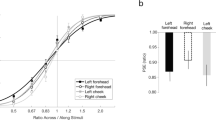Summary
Spherically curved surfaces were applied, with controlled force, to the fingerpads of human subjects; their fingers were immobilized. The curvature of the surfaces was characterised by the reciprocal of the radius of curvature. In scaling experiments, the subjects' perceived magnitude of curvature increased markedly with an increase in the curvature of the stimulus. An increase in contact force resulted in a slight decrease in perceived curvature. Four discrimination experiments were performed using a forced choice paradigm. Subjects could discriminate, at the 75% level, a flat surface (zero curvature) from a convex curvature of 4.9 m-1 (radius of curvature 204 mm) and from a concave curvature of 5.4 m-1 (radius 185 mm). When discriminating 2 convex spherical surfaces, subjects could discriminate a curvature of 144 m-1 from a curvature of 158 m-1 (radii 6.95 and 6.33 mm reespectively), and could discriminate a curvature of 287 m-1 from one of 319 m-1 (radii 3.48 and 3.13 mm respectively); the Weber fraction is about 0.1. Contact areas between the curved surfaces and the fingerpad skin were estimated. There was approximate correspondence between contact areas and the scaling functions.
Similar content being viewed by others
References
Ballard DH (1981) Generalizing the Hough transform to detect arbitrary shapes. Pattern Recog 13: 111–122
Blakemore C, Over R (1974) Curvature detectors in human vision?. Perception 3: 3–7
Browse RA (1987) Feature-based tactile object recognition. IEEE Trans PAMI-9: 779–786
Burgess PR, Wei JY, Clark FJ, Simon J (1982) Signaling of kinesthetic information by peripheral sensory receptors. Ann Rev Neurosci 5: 171–187
Davidson PW (1972) Haptic judgments of curvature by blind and sighted humans. J Exp Psychol 93:43–55
Davidson PW, Whitson TT (1974) Haptic equivalence matching of curvature by blind and sighted humans. J Exp Psychol 102: 687–690
Duda RO, Hart PE (1972) Use of the Hough transformation to detect lines and curves in pictures. Comm ACM 15: 11–15
Easton RD, Falzett M (1978) Finger pressure during tracking of curved contours: Implications for a visual dominance phenomenon. Percept Psychophys 24: 145–153
Evans AL, Harrison LM, Stephenes JA (1989) Task-dependent changes in cutaneous reflexes recorded from various muscles controlling finger movement in man. J Physiol (Lond) 418: 1–12
Fearing RS, Binford TO (1988) Using a cylindrical tactile sensor for determining curvature. Proc IEEE International Conference on Robotics and Automation 765–771
Freeman H (1961) On the encoding of arbitrary geometric configurations. IRE Trans EC-10: 260–268
Gordon IE, Morison V (1982) The haptic perception of curvature. Percept Psychophys 31: 446–450
Grupen RA, Henderson TC, McCammon ID (1989) A survey of general-purpose manipulation. Int J Robotics Res 8: 38–62
Gurfinkel VS, Shneyder AYu, Kanayev YeM, Gurfmkel YeV (1974) Tactile sensitizing of manipulators. Eng Cybern 12:47–56
Harmon LD (1985) Tactile sensing for robots. In: Beni G, Hackwood S (eds) Recent advances in robotics. John Wiley, New York, pp 389–419
Hulliger M, Nordh E, Thelin A-E, Vallbo AB (1979) The responses of afferent fibres from the glabrous skin of the human hand during voluntary finger movements in man. J Physiol (Lond) 291: 233–249
John KT, Goodwin AW, Darian-Smith I (1989) Tactile discrimination of thickness. Exp Brain Res 78: 62–68
Johnson KO (1980) Sensory descrimination: decision process. J Neurophysiol 43: 1771–1792
LaMotte RH, Srinivasan MA (1987a) Tactile discrimination of shape: responses of slowly adapting mechanoreceptive afferents to a step stroked across the monkey fingerpad. J Neurosci 7: 1655–1671
LaMotte RH, Srinivasan MA (1987b) Tactile discrimination of shape: responses of rapidly adapting mechanoreceptive afferents to a step stroked across the monkey fingerpad. J Neurosci 7: 1672–1681
Lederman SJ, Taylor MM (1972) Fingertip force, surface geometry, and the perception of roughness by active touch. Percept Psychophys 12: 401–408
Meyer-Arendt JR (1984) Introduction to classical and modern optics. Prentice-Hall, Englewood Cliffs
Nicholls HR, Lee MH (1989) A survey of robot tactile sensing technology. Int J Robotics Res 8: 3–30
Phillips CG (1986) Movements of the hand. Liverpool University Press, Liverpool
Phillips JR, Johnson KO (1981) Tactile spatial resolution. II. Neural representation of bars, edges, and gratings in monkey primary afferents. J Neurophysiol 46: 1192–1203
Ponce J, Brady M (1987) Toward a surface primal sketch. In: Kanade K (ed) Three-dimensional machine vision. Kluwer Academic Publishers, Boston, pp 195–240
Richards W, Dawson B, Whittington D (1986) Encoding contour shape by curvature extrema. J Opt Soc Am 3: 1483–1491
Riggs LA (1973) Curvature as a feature of pattern vision. Science 181: 1070–1072
Roland PE, Mortensen E (1987) Somatosensory detection of microgeometry, macrogeometry and kinesthesia in man. Brain Res Rev 12: 1–42
Shapiro SD (1978) Feature space transforms for curve detection. Pattern Recog 10: 129–143
Srinivasan MA, LaMotte RH (1987) Tactile discrimination of shape: responses of slowly and rapidly adapting mechanoreceptive afferents to a step indented into the monkey fingerpad. J Neurosci 7: 1682–1697
Srinivasan MA, LaMotte RH (1990) Encoding of shape in the responses of cutaneous mechanoreceptors. In: Franzen O, Westman J (eds) Information processing in the somatosensory system. MacMillan, London
Timney BN, Macdonald C (1978) Are curves detected by ‘curvature detectors’? Perception 7: 51–64
Wilson HR, Richards WA (1989) Mechanisms of contour curvature discrimination. J Opt Soc Am 6: 106–115
Author information
Authors and Affiliations
Rights and permissions
About this article
Cite this article
Goodwin, A.W., John, K.T. & Marceglia, A.H. Tactile discrimination of curvature by humans using only cutaneous information from the fingerpads. Exp Brain Res 86, 663–672 (1991). https://doi.org/10.1007/BF00230540
Received:
Accepted:
Issue Date:
DOI: https://doi.org/10.1007/BF00230540




